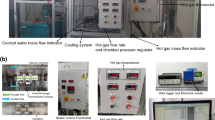Abstract
This study utilizes a versatile superposition method with thermal resistance network analysis to design and experiment on a thermal module with embedded six L-shaped or two U-shaped heat pipes and plate fins under different fan speeds and heat source areas. This type of heat pipes-heat sink module successively transfer heat capacity from a heat source to the heat pipes, the heat sink and their surroundings, and are suitable for cooling electronic systems via forced convection mechanism. The thermal resistances contain all major components from the thermal interface through the heat pipes and fins. Thermal performance testing shows that the lowest thermal resistances of the representative L- and U-shaped heat pipes-heat sink thermal modules are respectively 0.25 and 0.17 °C/W under twin fans of 3,000 RPM and 30 × 30 mm2 heat sources. The result of this work is a useful thermal management method to facilitate rapid analysis.









Similar content being viewed by others
Abbreviations
- K:
-
Thermal conductivity (W/m °C)
- Q:
-
Total heat transfer rate (W)
- R:
-
Thermal resistance (°C/W)
- Rt :
-
Total thermal resistance (°C/W)
- T:
-
Temperature (°C)
- a:
-
Air/ambient
- b:
-
Base plate
- f:
-
Fin
- s:
-
Heat source/dummy heater
- n:
-
Position of embedded L-/n-shaped heat pipes
References
Chang Y-W et al (2008) Heat pipe for cooling of electronic equipment. Energy Convers Manag 49:3398–3404. doi:10.1016/j.enconman.2008.05.002
Azad E (2012) Predict the temperature distribution in gas-to-gas heat pipe heat exchanger. Heat Mass Transf 48:1177–1181
Kaya T, Goldak J (2007) Three-dimensional numerical analysis of heat and mass transfer in heat pipes. Heat Mass Transf 43:775–785
Uddin AI, Feroz CM (2009) Effect of working fluid on the performance of a miniature heat pipe system for cooling desktop processor. Heat Mass Transf 46:113–118
Tsai T-E et al (2010) Dynamic test method for determining the thermal performances of heat pipes. Int J Heat Mass Transf 53:4567–4578
Wang J-C et al (2007) Experimental investigations of thermal resistance of a heat sink with horizontal embedded heat pipes. Int Commun Heat Mass Transf 34:958–970. doi:10.1016/j.icheatmasstransfer.2007.03.015
El-Nasr AA, El-Haggar SM (1996) Effective thermal conductivity of heat pipes. Heat Mass Transf 32:97–101
Wang R-T et al (2011) Experimental analysis for thermal performance of a vapor chamber applied to high-performance servers. J Mar Sci Technol Taiwan 19:353–360
Chi SW (1976) Heat pipe theory and practice: a sourcebook (Chapter 1), 1st edn. Hemisphere Publishing Corporation, New York, pp 1–30
Wang J-C (2011) Investigations on non-condensation gas of a heat pipe. Engineering 3:376–383
Dunn P, Reay DA (1976) Heat pipes (Chapter 2), 1st edn. Pergamon Press, Oxford, pp 18–87
Wang R-T, Wang J-C (2012) Analyzing the pressure-difference phenomenon between the condensing and boiling sections in a heat pipe cooling system. Int Commun Heat Mass Transf 39:390–398
Gai D et al (2009) Operational characteristics of miniature loop heat pipe with flat evaporator. Heat Mass Transf 46:267–275
Wang J-C (2009) Superposition method to investigate the thermal performance of heat sink with embedded heat pipes. Int Commun Heat Mass Transf 36:686–692. doi:10.1016/j.icheatmasstransfer.2009.04.008
Wang J-C et al (2010) Program for rapid computation of the thermal performance of a heat sink with embedded heat pipes. J Chin Soc Mech Eng 31:21–28
Wang R-T (2013) A fitting, simple and versatile window program (HSHPTM) design using lumped parameters and one-dimensional thermal resistance models. Heat Mass Transf 49:291–297
Russel MK et al (2011) The effect of orientation on U-shaped grooved and sintered wick heat pipes. Appl Therm Eng 31:69–76
Liang T-S, Hung Y-M (2010) Experimental investigation on the thermal performance and optimization of heat sink with U-shape heat pipes. Energy Convers Manag 51:2109–2116. doi:10.1016/j.enconman.2010.03.003
Elnaggar Mohamed HA et al (2012) Characterization of working fluid in vertically mounted finned U-shape twin heat pipe for electronic cooling. Energy Convers Manag 62:31–39
Elnaggar Mohamed HA et al (2011) Experimental analysis and FEM simulation of finned U-shape multi heat pipe for desktop PC cooling. Energy Convers Manag 52:2937–2944. doi:10.1016/j.enconman.2011.03.001
Wang J-C (2011) L-type heat pipes application in electronic cooling system. Int J Therm Sci 50:97–105. doi:10.1016/j.ijthermalsci.2010.07.001
Li X et al (2013) Capillary limit of micro heat pipe with compound structure of sintered wick on trapezium-grooved substrate. Heat Mass Transf 49:381–389
Senthilkumar R et al (2012) Comparative study on heat pipe performance using aqueous solutions of alcohols. Heat Mass Transf 48:2033–2040
Alaei A et al (2013) A vertical heat pipe: an experimental and statistical study of the thermal performance in the presence of low-frequency vibrations. Heat Mass Transf 49:285–290
Wang J-C (2012) 3-D numerical and experimental models for flat and embedded heat pipes applied in high-end VGA card cooling system. Int Commun Heat Mass Transf 39:1360–1366
Wang J-C (2010) Development of vapour chamber-based VGA thermal module. Int J Numer Meth Heat Fluid Flow 20:416–428. doi:10.1108/09615531011035811
Lu X-Y et al (2011) Thermal analysis of high power LED package with heat pipe heat sink. Microelectron J 42:1257–1262
Wang J-C (2011) Thermal investigations on LEDs vapor chamber-based plates. Int Commun Heat Mass Transf 38:1206–1212
Wang J-C et al (2010) Development of 30 Watt high-power LEDs vapor chamber-based plate. Int J Heat Mass Transf 53:3900–4001. doi:10.1016/j.ijheatmasstransfer.2010.05.018
Wang J-C (2014) U- and L-shaped heat pipes heat sinks for cooling electronic components employed a least square smoothing method. Microelectron Reliab. doi:10.1016/j.microrel.2014.02.034
Acknowledgments
The author gratefully acknowledgments the financial support from NSC 101-2221-E-019-042—for the present study. Finally, the author would like to thank all colleagues and students who contributed to this study.
Author information
Authors and Affiliations
Corresponding author
Rights and permissions
About this article
Cite this article
Wang, JC. L- and U-shaped heat pipes thermal modules with twin fans for cooling of electronic system under variable heat source areas. Heat Mass Transfer 50, 1487–1498 (2014). https://doi.org/10.1007/s00231-014-1358-5
Received:
Accepted:
Published:
Issue Date:
DOI: https://doi.org/10.1007/s00231-014-1358-5




